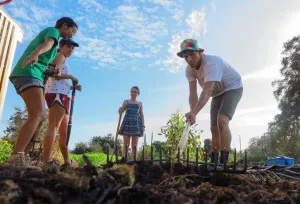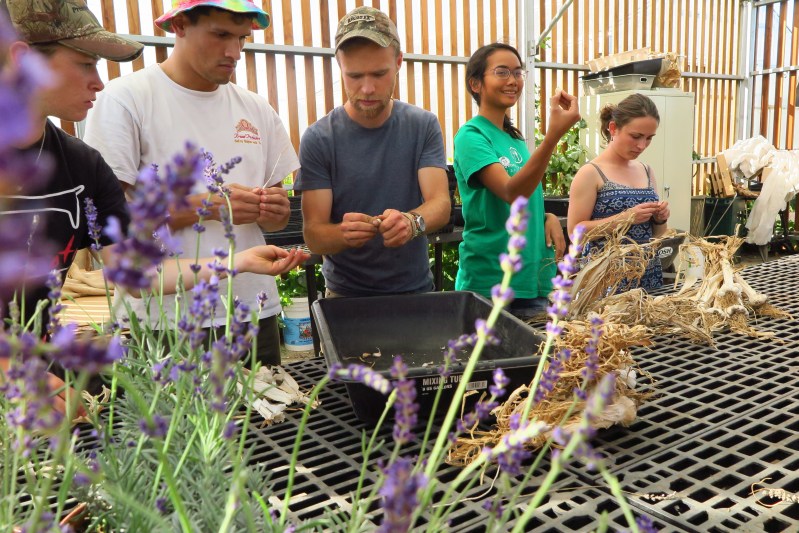
EARTHSYS 180B, “Principles and Practices of Sustainable Agriculture,” takes students outdoors to Stanford’s Educational Farm for a hands-on environmental studies experience where they learn everything from plant anatomy to composting.
Students meet twice a week — once for a conventional indoor lecture, and once for a lab section held at the six-acre O’Donohue Family Stanford Educational Farm, which is located on West Campus and opened just last spring.
“Part of our pedagogy in environmental science is that we want to get people out in the world,” said Patrick Archie, a lecturer in the School of Earth, Energy, and Environmental Sciences. “We don’t just teach from the book, or in a cloistered setting.”
“It’s easy to get theoretical and abstract when you’re not engaged on the front lines with the problem,” he added.
The class, which focuses on teaching ecologically sound agricultural techniques, fulfills the “Scientific Method and Analysis” WAYS requirement, as well as the “Applied Study in the Field” requirement for earth systems majors in the sustainable food and agriculture track.
At last Wednesday’s lab section, Archie led small groups through an activity on asexual reproduction in plants. Students snipped plants into three-to-four-inch pieces that, with proper care, will put out roots and grow.
Archie’s lesson ran more like a conversation as students chimed in frequently with questions about everything from cutting technique, to “Is this plant edible?”— for Cuban mint, the answer was yes, and students proceeded to taste it.
“Pepper me with questions; I love it,” Archie said.
When not working with Archie, students were out in the sun and dirt, shoveling and preparing soil beds for planting.
Before the Educational Farm was opened, EARTHSYS 180B was a one-sixth-acre garden plot within the old Stanford Community Farm. The new space offers expanded opportunities for hands-on work in his class, Archie said.
According to Archie, the larger plot allows students to work with more diverse plants, as well as new tools, like a tractor. The course still benefits from field trips to bigger farms, but students can also learn larger-scale farming techniques more conveniently.
“It’s difficult to do stuff in the field when you’re in the midst of the quarter and you’ve got a bunch of other courses, and so having a farm that we can literally walk to just down the road is great,” Archie said.
Archie said that readings and traditional lecture are important, but that hands-on work helps reinforce students’ knowledge. Over his five years of teaching the course, he has increased the amount of class time spent outside.
EARTHSYS 180B student Pablo Haake ’19 agreed that hands-on experience has enhanced the course material.
“I think you care a lot more about something when you see it in action — when you can see the vegetables and fruits growing,” Haake said.
Even in homework assignments, students of the class encounter practical applications. Last week, they began work on a group project that will help shape the Educational Farm. Each team is tasked with researching a different of subset of perennials, such as cane berries or stone fruits, and recommending particular species to plant at Stanford.
According to Archie, his class comprises a wide range of ages, from freshmen to graduate students, as well as a range of academic interests.
“In general, in our society right now, everyone’s gotten really interested in food,” Archie said. “I think at Stanford, too, people see food as an interesting nexus, it’s a way of making lots of different connections.”
For example, current EARTHSYS 180B student Aitrin Doan ’18 came to the course through an interest in international relations, particularly food and water security.
Doan also said that she likes smaller classes with a hands-on component, mentioning a Community Engaged Learning (CEL) course she enjoyed last year. CEL classes interact with the broader community around Stanford.
Deputy Director of the Earth Systems program Richard Nevle Ph.D. ’95 recalled his own experience as a graduate student at Stanford, saying that in-the-field learning has always been important to the earth and environmental sciences.
“It’s not a new thing at all,” he said. “It’s just the way that we teach.”
“You can’t really appreciate the scale at which the Earth Systems processes occur without moving classroom to the outdoors,” Nevle added.
He described a variety of options for experiential learning in the Earth Systems department, from a quarter-long program in Hawaii to short weekend trips to Sophomore College courses in the Rocky Mountains and Alaska.
Nevle emphasized that these in-the-field programs are aimed not just at Earth Systems majors, but at the entire Stanford community.
“In my perfect Stanford world, every single student on campus would take at least one course… to help them gain environmental literacy,” he said. “And I think that hands-on, field-learning opportunities are really an incredible and fun way to do that.”
Contact Hannah Knowles at hknowles ‘at’ stanford.edu.
Photo Gallery by Nina Zubrilina
[justified_image_grid ids=”1104687, 1104688, 1104689, 1104690, 1104693, 1104694, 1104695″ row_height=300]
